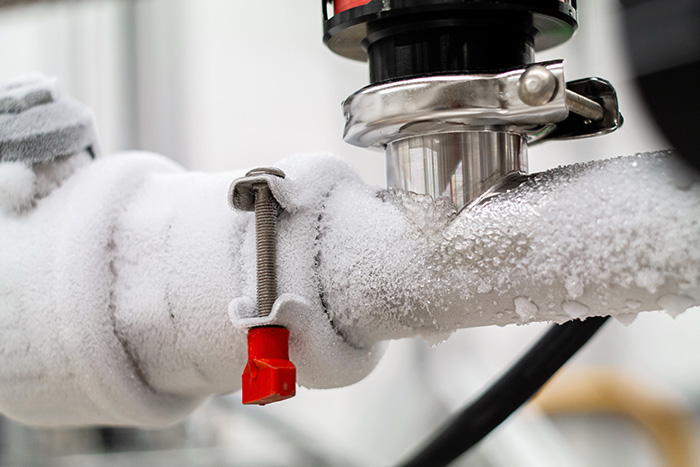Preventing Frozen Pipes in Cold Weather: Expert Tips
Preventing Frozen Pipes in Cold Weather: Expert Tips
Blog Article
They are making a number of great observations on the subject of Prevent Frozen Pipes overall in this article down below.

Cold weather can wreak havoc on your plumbing, specifically by freezing pipes. Below's just how to prevent it from occurring and what to do if it does.
Introduction
As temperatures drop, the danger of frozen pipelines boosts, possibly causing expensive fixings and water damage. Comprehending how to prevent frozen pipes is critical for house owners in chilly climates.
Understanding Icy Pipes
What causes pipes to freeze?
Pipes ice up when exposed to temperature levels below 32 ° F (0 ° C) for prolonged periods. As water inside the pipelines ices up, it expands, putting pressure on the pipe walls and possibly triggering them to burst.
Dangers and damages
Icy pipelines can result in water system interruptions, home damage, and pricey fixings. Ruptured pipes can flooding homes and trigger substantial architectural damage.
Indications of Frozen Water Lines
Identifying frozen pipes early can stop them from bursting.
Just how to determine frozen pipelines
Seek lowered water flow from faucets, uncommon odors or noises from pipes, and visible frost on exposed pipes.
Prevention Tips
Shielding at risk pipes
Wrap pipelines in insulation sleeves or utilize heat tape to protect them from freezing temperatures. Focus on pipes in unheated or outside locations of the home.
Home heating techniques
Keep indoor spaces appropriately heated up, specifically locations with pipes. Open closet doors to enable warm air to flow around pipes under sinks.
Safeguarding Outside Plumbing
Garden tubes and outside faucets
Disconnect and drain garden hose pipes prior to winter. Install frost-proof faucets or cover exterior faucets with protected caps.
What to Do If Your Pipelines Freeze
Immediate activities to take
If you presume frozen pipes, keep taps open up to relieve pressure as the ice melts. Utilize a hairdryer or towels soaked in hot water to thaw pipes gradually.
Long-Term Solutions
Architectural modifications
Think about rerouting pipes far from outside wall surfaces or unheated locations. Add extra insulation to attics, basements, and crawl spaces.
Updating insulation
Purchase premium insulation for pipes, attic rooms, and walls. Correct insulation assists maintain regular temperatures and minimizes the risk of icy pipes.
Conclusion
Avoiding frozen pipelines calls for proactive measures and fast reactions. By understanding the reasons, indicators, and safety nets, home owners can secure their pipes throughout winter.
6 Proven Ways to Prevent Frozen Pipes and Protect Your Home
Disconnect and Drain Garden Hoses
Before winter arrives, start by disconnecting your garden hoses and draining any remaining water. Close the shut-off valves that supply outdoor hose bibs and leave the outdoor faucet open to allow any residual water to drain. For extra protection, consider using faucet covers throughout the colder months. It’s also important to drain water from any sprinkler supply lines following the manufacturer’s directions.
Insulate Exposed Pipes
Insulating your pipes is an effective way to prevent freezing. Pipe insulation is readily available at home improvement stores and is relatively inexpensive. Pay close attention to pipes in unheated areas such as the attic, basement, crawl spaces, or garage. Apply foam insulation generously to create a buffer against the cold. You can also wrap your pipes in heat tape or thermostat-controlled heat cables for added warmth.
Seal Air Leaks
Inspect your home for any cracks or openings that could let in cold air. Seal any holes around the piping in interior or exterior walls, as well as the sill plates where your home rests on its foundation. Additionally, make sure to keep your garage door closed unless you’re entering or exiting. Leaving it open creates a significant air leak that can lead to frozen pipes.
Allow Warm Air Circulation
During cold snaps, it’s essential to allow warm air to circulate evenly throughout your home. Leave interior doors ajar to promote better airflow. Open kitchen and bathroom cabinets to help distribute heat consistently around the rooms. If you have small children or pets, be sure to remove any household chemicals or potentially harmful cleaners from open cabinets for safety.
Let Faucets Drip
A small trickle of water can make a big difference in preventing ice formation inside your pipes. When temperatures drop significantly, start a drip of water from all faucets served by exposed pipes. This continuous flow helps prevent the water from freezing. Additionally, running a few faucets slightly can relieve pressure inside the pipes, reducing the chances of a rupture if the water inside does freeze.
https://choateshvac.com/6-proven-ways-to-prevent-frozen-pipes-and-protect-your-home/

Do you appreciate reading up on How To Avoid Freezing Pipes? Give a comment down the page. We'd be glad to hear your views about this posting. We are looking forward to see you back again in the near future. In case you liked our blog post plz don't forget to share it. Thanks a lot for your time spent reading it.
Click Here Report this page